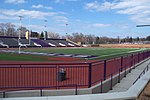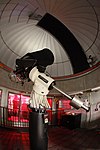University of St. Thomas (Minnesota)
1885 establishments in MinnesotaAssociation of Catholic Colleges and UniversitiesCatholic universities and colleges in MinnesotaEducational institutions established in 1885Liberal arts colleges in Minnesota ... and 4 more
Universities and colleges in MinneapolisUniversities and colleges in Saint Paul, MinnesotaUniversity of St. Thomas (Minnesota)Use mdy dates from April 2012
The University of St. Thomas (St. Thomas) is a private, Catholic university in St. Paul and Minneapolis, Minnesota. Founded in 1885 as a Catholic seminary, it is named after Thomas Aquinas, the medieval Catholic theologian and philosopher who is the patron saint of students. As of fall 2021, St. Thomas enrolls nearly 9,347 students, making it Minnesota's largest private, nonprofit university.
Excerpt from the Wikipedia article University of St. Thomas (Minnesota) (License: CC BY-SA 3.0, Authors).University of St. Thomas (Minnesota)
UST Arches, Saint Paul Union Park
Geographical coordinates (GPS) Address Nearby Places Show on map
Geographical coordinates (GPS)
| Latitude | Longitude |
|---|---|
| N 44.943055555556 ° | E -93.190277777778 ° |
Address
Anderson Athletic Center
UST Arches
55114 Saint Paul, Union Park
Minnesota, United States
Open on Google Maps








